Deep Learning for Knock Occurrence Prediction in SI Engines
Abstract
1. Introduction
2. Method
2.1. Dataset
2.2. Deep Learning Model
2.3. Evaluation
2.4. Imbalanced Learning
- Undersampling
- Cost-sensitive learning
2.5. k-Fold Cross-Validation
3. Results and Discussion
3.1. Reference Model
3.2. Influence of the Start CA on Prediction
3.3. Influence of the End CA on Prediction
3.4. Using Multiple Operating Conditions for Deep Learning
- For operating conditions ➀–➃ and operating conditions that used the same engine and fuel but are not used for deep learning, determine the timing (hereafter called the candidate for the end CA) that separates the spark timing and the timing of maximum in-cylinder pressure at 3:1.(This 3:1 ratio is necessary because the 0° ATDC, which splits about 3:1 between −31.5° ATDC and around 10° ATDC when knocking occurs, was important in operating condition ➀ used in Section 3.1, Section 3.2, Section 3.3)
- For each operating condition, plot the candidate for the end CA against the spark timing and approximate it with a quadratic polynomial.
- Let f be an approximation formula and use end CA = f (spark timing) to determine the end CA to be used for knock prediction for each operating condition.
4. Conclusions
- Using only the in-cylinder pressure data before the onset of knocking, the prediction accuracy was 91.4%, and both precision and recall were over 70%. In addition, cost-sensitive learning was applied to tackle the imbalance in the amount of data between the knock cycle and the non-knock cycle. When we adjusted the weight, this approach was able to control the balance between precision and recall.
- Changing the start CA of the pressure history input to the neural network, including the pressure history of the previous cycle, did not influence the classification accuracy, and the early stage of combustion was found to greatly affect the knock occurrence.
- Changing the end CA of the pressure history input to the neural network, even if data up to the timing immediately before the knocking were not used, enabled the prediction of knock occurrence with the same accuracy as when data up to the timing immediately before the knock occurrence were used.
- When multiple operating conditions were used for deep learning, the prediction accuracy remained high, but the recall was decreased compared to the model using a single operating condition, as a result of interference among the conditions.
Author Contributions
Funding
Data Availability Statement
Acknowledgments
Conflicts of Interest
References
- Wang, Z.; Liu, H.; Reitz, R.D. Knocking combustion in spark-ignition engines. Prog. Energy Combust. Sci. 2017, 61, 78–112. [Google Scholar] [CrossRef]
- Zhen, X.; Wang, Y.; Xu, S.; Zhu, Y.; Tao, C.; Xu, T.; Song, M. The engine knock analysis—An overview. Appl. Energy 2012, 92, 628–636. [Google Scholar] [CrossRef]
- Kiencke, U. Automotive Control Systems for Engine, Driveline, and Vehicle, 2nd ed.; Springer: Berlin/Heidelberg, Germany, 2005. [Google Scholar]
- Kalghatgi, G.; Algunaibet, I.; Morganti, K. On knock intensity and superknock in SI engines. SAE Int. J. Engines 2017, 10, 1051–1063. [Google Scholar] [CrossRef]
- LeCun, Y.; Bengio, Y.; Hinton, G. Deep learning. Nature 2015, 521, 436–444. [Google Scholar] [CrossRef] [PubMed]
- Ma, Y.; Wang, Z.; Yang, H.; Yang, L. Artificial intelligence applications in the development of autonomous vehicles: A survey. IEEE/CAA J. Autom. Sin. 2020, 7, 315–329. [Google Scholar] [CrossRef]
- Taghavifar, H.; Taghavifar, H.; Mardani, A.; Mohebbi, A.; Khalilarya, S.; Jafarmadar, S. Appraisal of artificial neural networks to the emission analysis and prediction of CO2, soot, and NOx of n-heptane fueled engine. J. Clean. Prod. 2016, 112, 1729–1739. [Google Scholar] [CrossRef]
- Kapusuz, M.; Ozcan, H.; Yamin, J.A. Research of performance on a spark ignition engine fueled by alcohol-gasoline blends using artificial neural networks. Appl. Therm. Eng. 2015, 91, 525–534. [Google Scholar] [CrossRef]
- Chakraborty, A.; Roy, S.; Banerjee, R. An experimental based ANN approach in mapping performance-emission characteristics of a diesel engine operating in dual-fuel mode with LPG. J. Nat. Gas Sci. Eng. 2016, 28, 15–30. [Google Scholar] [CrossRef]
- Lotfan, S.; Ghiasi, R.A.; Fallah, M.; Sadeghi, M.H. ANN-based modeling and reducing dual-fuel engine’s challenging emissions by multi-objective evolutionary algorithm NSGA-II. Appl. Energy 2016, 175, 91–99. [Google Scholar] [CrossRef]
- Domínguez-Sáez, A.; Rattá, G.A.; Barrios, C.C. Prediction of exhaust emission in transient conditions of a diesel engine fueled with animal fat using artificial neural network and symbolic regression. Energy 2018, 149, 675–683. [Google Scholar] [CrossRef]
- Fang, X.H.; Papaioannou, N.; Leach, F.; Davy, M.H. On the application of artificial neural networks for the prediction of NOx emissions from a high-speed direct injection diesel engine. Int. J. Engine Res. 2021, 22, 1808–1824. [Google Scholar] [CrossRef]
- Sayin, C.; Ertunc, H.M.; Hosoz, M.; Kilicaslan, I.; Canakci, M. Performance and exhaust emissions of a gasoline engine using artificial neural network. Appl. Therm. Eng. 2007, 27, 46–54. [Google Scholar] [CrossRef]
- Ghobadian, B.; Rahimi, H.; Nikbakht, A.M.; Najafi, G.; Yusaf, T.F. Diesel engine performance and exhaust emission analysis using waste cooking biodiesel fuel with an artificial neural network. Renew. Energy 2009, 34, 976–982. [Google Scholar] [CrossRef]
- Yusaf, T.F.; Buttsworth, D.R.; Saleh, K.H.; Yousif, B.F. CNG-diesel engine performance and exhaust emission analysis with the aid of artificial neural network. Appl. Energy 2010, 87, 1661–1669. [Google Scholar] [CrossRef]
- Javed, S.; Satyanarayana Murthy, Y.V.V.; Baig, R.U.; Prasada Rao, D. Development of ANN model for prediction of performance and emission characteristics of hydrogen dual fueled diesel engine with Jatropha Methyl Ester biodiesel blends. J. Nat. Gas Sci. Eng. 2015, 26, 549–557. [Google Scholar] [CrossRef]
- Channapattana, S.V.; Pawar, A.A.; Kamble, P.G. Optimisation of operating parameters of DI-CI engine fueled with second generation Bio-fuel and development of ANN based prediction model. Appl. Energy 2017, 187, 84–95. [Google Scholar] [CrossRef]
- Mehra, R.K.; Duan, H.; Luo, S.; Rao, A.; Ma, F. Experimental and artificial neural network (ANN) study of hydrogen enriched compressed natural gas (HCNG) engine under various ignition timings and excess air ratios. Appl. Energy 2018, 228, 736–754. [Google Scholar] [CrossRef]
- Finesso, R.; Spessa, E.; Yang, Y.; Conte, G.; Merlino, G. Neural-network based approach for real-time control of BMEP and MFB50 in a euro 6 diesel engine. SAE Tech. Pap. 2017. [Google Scholar] [CrossRef]
- Luján, J.M.; Climent, H.; García-Cuevas, L.M.; Moratal, A. Volumetric efficiency modelling of internal combustion engines based on a novel adaptive learning algorithm of artificial neural networks. Appl. Therm. Eng. 2017, 123, 625–634. [Google Scholar] [CrossRef]
- Taghavifar, H.; Mardani, A.; Mohebbi, A.; Taghavifar, H. Investigating the effect of combustion properties on the accumulated heat release of di engines at rated EGR levels using the ANN approach. Fuel 2014, 137, 1–10. [Google Scholar] [CrossRef]
- Taghavifar, H.; Khalilarya, S.; Jafarmadar, S. Diesel engine spray characteristics prediction with hybridized artificial neural network optimized by genetic algorithm. Energy 2014, 71, 656–664. [Google Scholar] [CrossRef]
- Gürgen, S.; Ünver, B.; Altın, İ. Prediction of cyclic variability in a diesel engine fueled with n-butanol and diesel fuel blends using artificial neural network. Renew. Energy 2018, 117, 538–544. [Google Scholar] [CrossRef]
- Fujiwara, S.; Iwase, M.; Satoh, Y. Near Boundary Control of Automotive Engine using Machine Learning. In Proceedings of the International Conference on Advanced Mechatronic Systems (ICAMechS), Hanoi, Vietnam, 10–13 December 2020; pp. 69–73. [Google Scholar]
- Jung, D.; Hwang, I.; Jo, Y.; Jang, C.; Han, M.; Sunwoo, M.; Chang, J.H. In-cylinder pressure-based convolutional neural network for real-time estimation of low-pressure cooled exhaust gas recirculation in turbocharged gasoline direct injection engines. Int. J. Engine Res. 2021, 22, 815–826. [Google Scholar] [CrossRef]
- Kuzhagaliyeva, N.; Thabet, A.; Singh, E.; Ghanem, B.; Sarathy, S.M. Using deep neural networks to diagnose engine pre-ignition. Proc. Combust. Inst. 2021, 38, 5915–5922. [Google Scholar] [CrossRef]
- Shin, S.; Lee, S.; Kim, M.; Park, J.; Min, K. Deep learning procedure for knock, performance and emission prediction at steady-state condition of a gasoline engine. Proc. Inst. Mech. Eng. Part D J. Automob. Eng. 2020, 234, 3347–3361. [Google Scholar] [CrossRef]
- Zhou, Z.; Xiong, S.; Chen, Y.; Zhang, C.; Cao, Y. Deep learning approach for super-knock event prediction of petrol engine with sample imbalance. Fuel 2022, 311, 122509. [Google Scholar] [CrossRef]
- Cho, S.; Park, J.; Song, C.; Oh, S.; Lee, S.; Kim, M.; Min, K. Prediction modeling and analysis of knocking combustion using an improved 0D RGF model and supervised deep learning. Energies 2019, 12, 844. [Google Scholar] [CrossRef]
- Kefalas, A.; Ofner, A.B.; Pirker, G.; Posch, S.; Geiger, B.C.; Wimmer, A. Detection of knocking combustion using the continuous wavelet transformation and a convolutional neural network. Energies 2021, 14, 439. [Google Scholar] [CrossRef]
- Ofner, A.B.; Kefalas, A.; Posch, S.; Geiger, B.C. Knock detection in combustion engine time series using a theory-guided 1-D convolutional neural network approach. IEEE/ASME Trans. Mechatron. 2022, 27, 4101–4111. [Google Scholar] [CrossRef]
- Tsuboi, S.; Miyokawa, S.; Matsuda, M.; Yokomori, T.; Iida, N. Influence of spark discharge characteristics on ignition and combustion process and the lean operation limit in a spark ignition engine. Appl. Energy 2019, 250, 617–632. [Google Scholar] [CrossRef]
- Draper, C.S. Pressure waves accompanying detonation in the internal combustion engine. J. Aeronaut. Sci. 1938, 5, 219–226. [Google Scholar] [CrossRef]
- Nagasawa, T.; Okura, Y.; Yamada, R.; Sato, S.; Kosaka, H.; Yokomori, T.; Iida, N. Thermal efficiency improvement of super-lean burn spark ignition engine by stratified water insulation on piston top surface. Int. J. Engine Res. 2020, 22, 1421–1439. [Google Scholar] [CrossRef]
- Goodfellow, I.; Bengio, Y.; Courville, A. Deep Learning; The MIT Press: Cambridge, MA, USA, 2016. [Google Scholar]
- Kingma, D.P.; Ba, L.J. Adam: A Method for Stochastic Optimization. In Proceedings of the International Conference on Learning Representations (ICLR), San Diego, CA, USA, 7–9 May 2015; pp. 1–15. [Google Scholar]
- Ioffe, S.; Szegedy, C. Batch Normalization: Accelerating Deep Network Training by Reducing Internal Covariate Shift. In Proceedings of the 32nd International Conference on International Conference on Machine Learning, Lille, France, 6–11 July 2015; pp. 448–456. [Google Scholar]
- Srivastava, N.; Hinton, G.; Krizhevsky, A.; Sutskever, I.; Salakhutdinov, R. Dropout: A simple way to prevent neural networks from overfitting. J. Mach. Learn. Res. 2014, 15, 1929–1958. [Google Scholar]
- Krawczyk, B. Learning from imbalanced data: Open challenges and future directions. Prog. Artif. Intell. 2016, 5, 221–232. [Google Scholar] [CrossRef]
- Classification Output Layer—MATLAB Classification Layer. Available online: https://www.mathworks.com/help/deeplearning/ref/classificationlayer.html (accessed on 14 October 2022).
- Cui, Y.; Jia, M.; Lin, T.Y.; Song, Y.; Belongie, S. Class-Balanced Loss Based on Effective Number of Samples. In Proceedings of the 2019 IEEE/CVF Conference on Computer Vision and Pattern Recognition (CVPR), Long Beach, CA, USA, 15–20 June 2019; pp. 9260–9269. [Google Scholar]
- Miyoshi, A. Chemical kinetic analysis on the effect of the occurrence of cool flame on SI knock. Int. J. Automot. Eng. 2017, 8, 130–136. [Google Scholar] [CrossRef][Green Version]
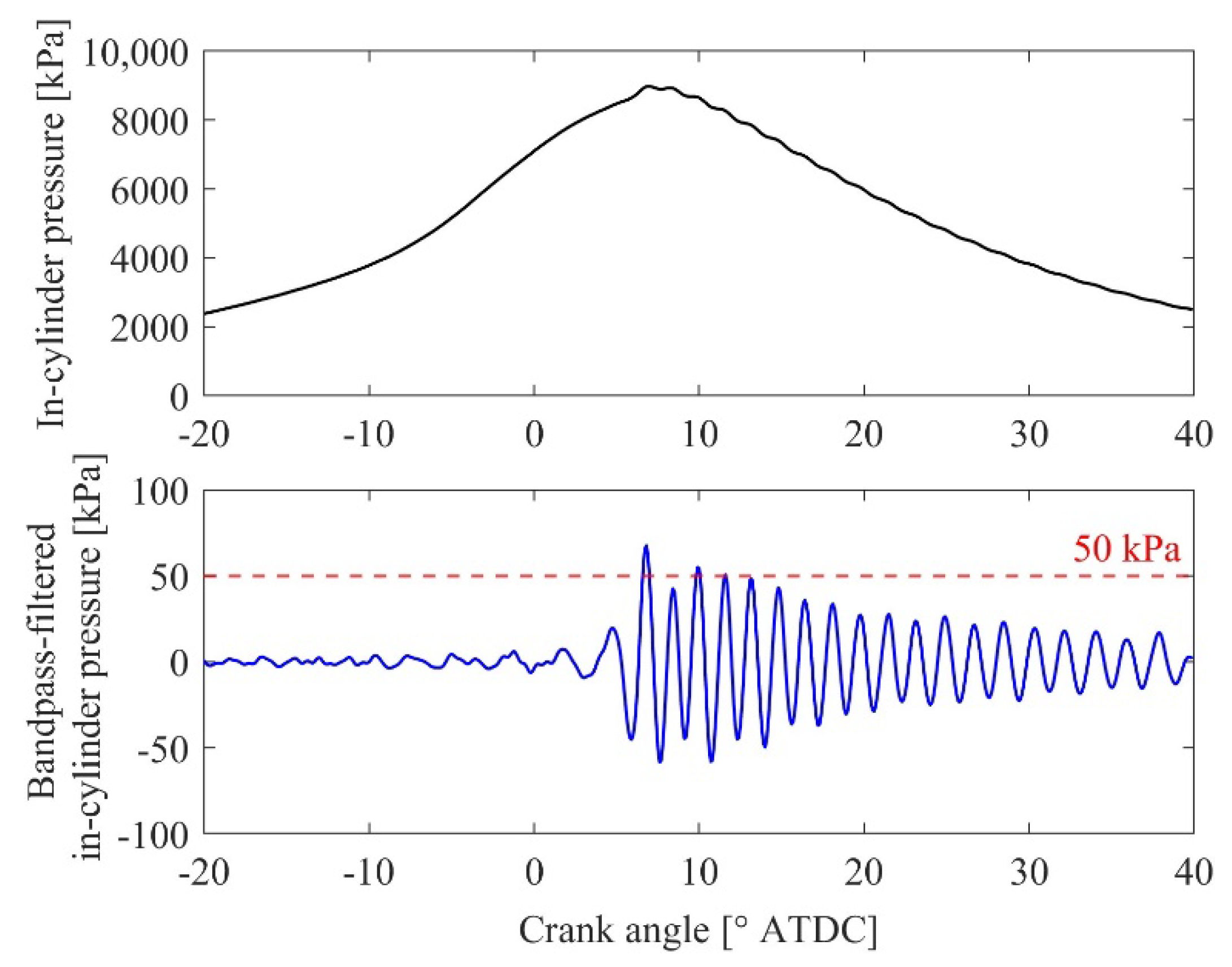

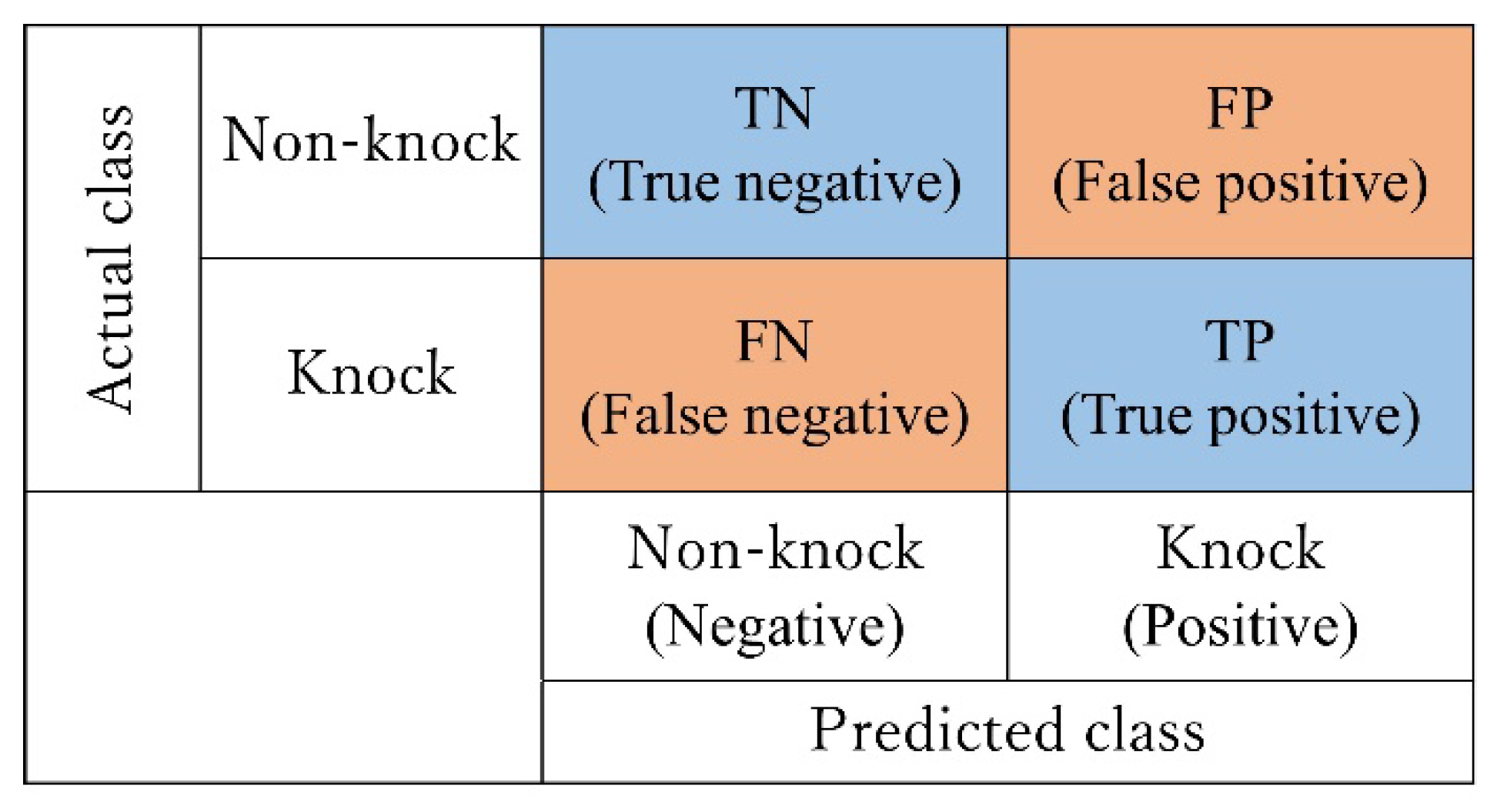
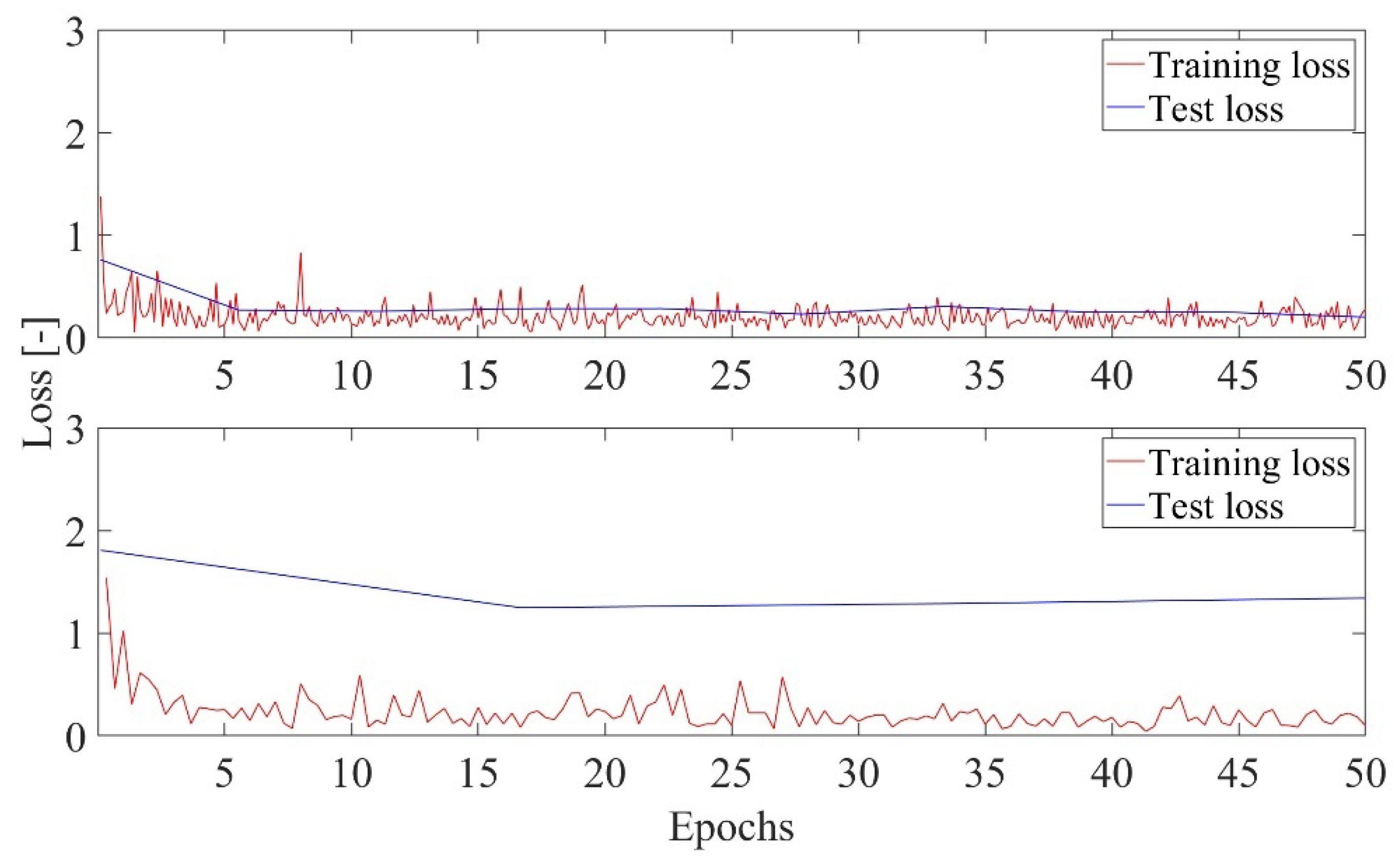
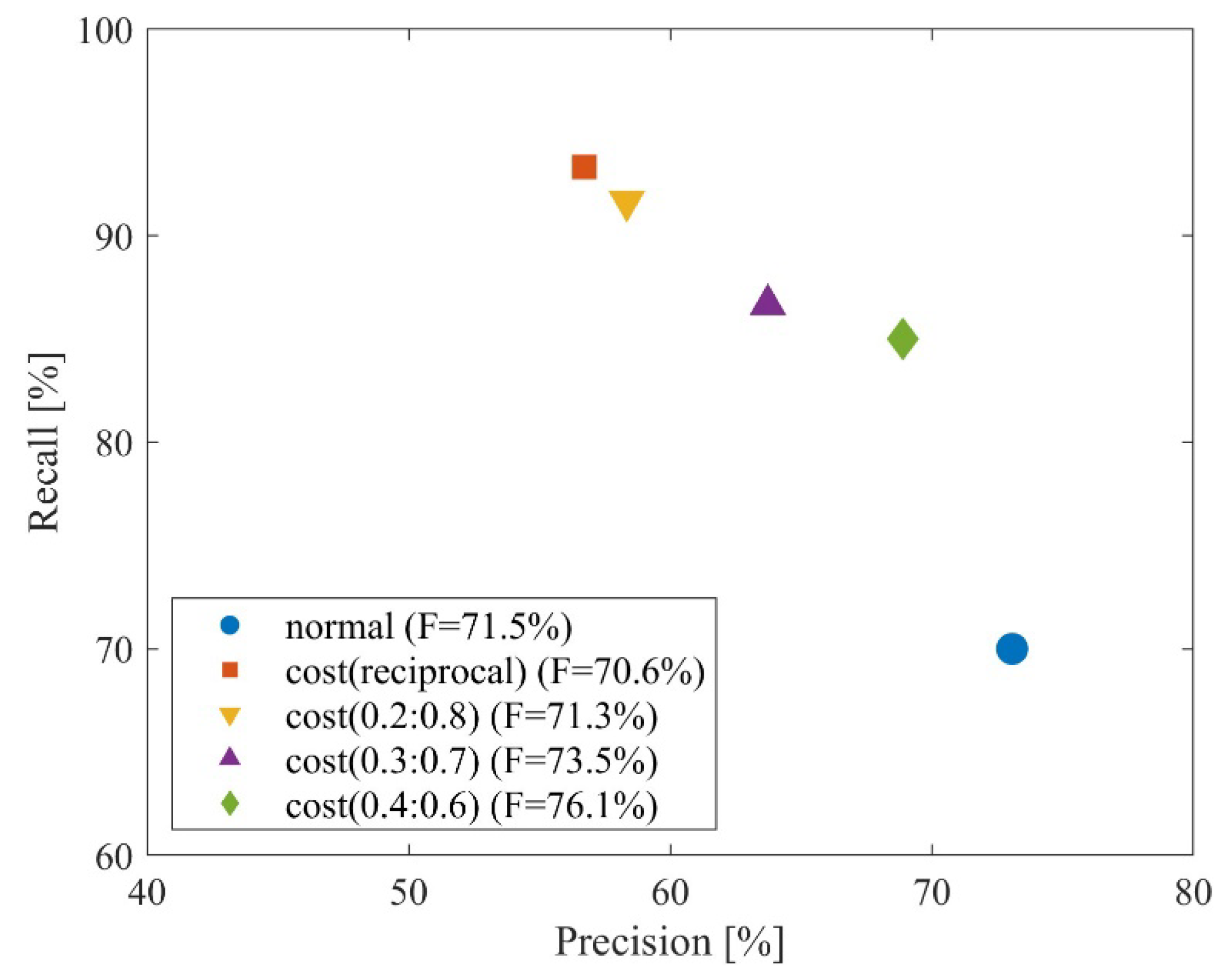



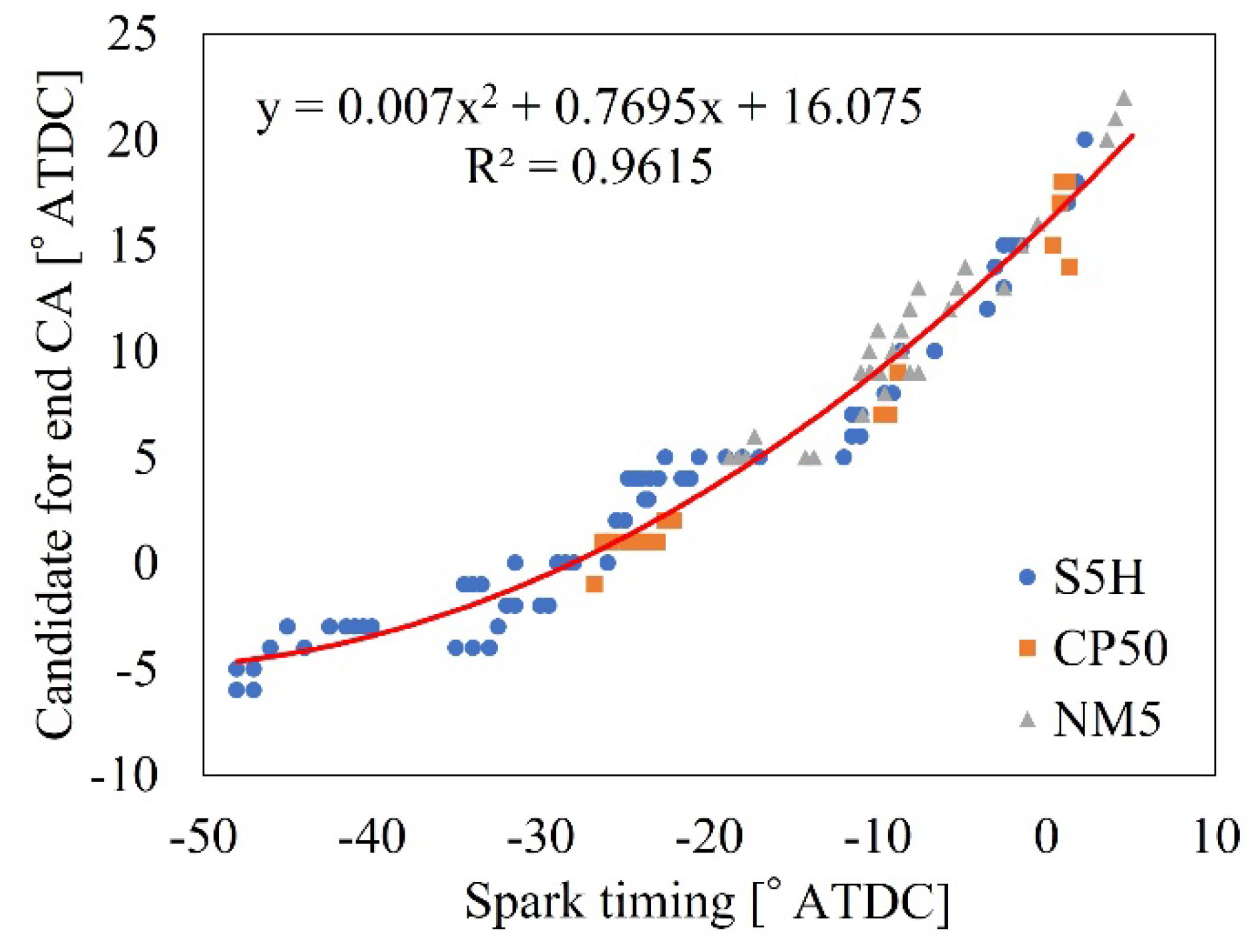
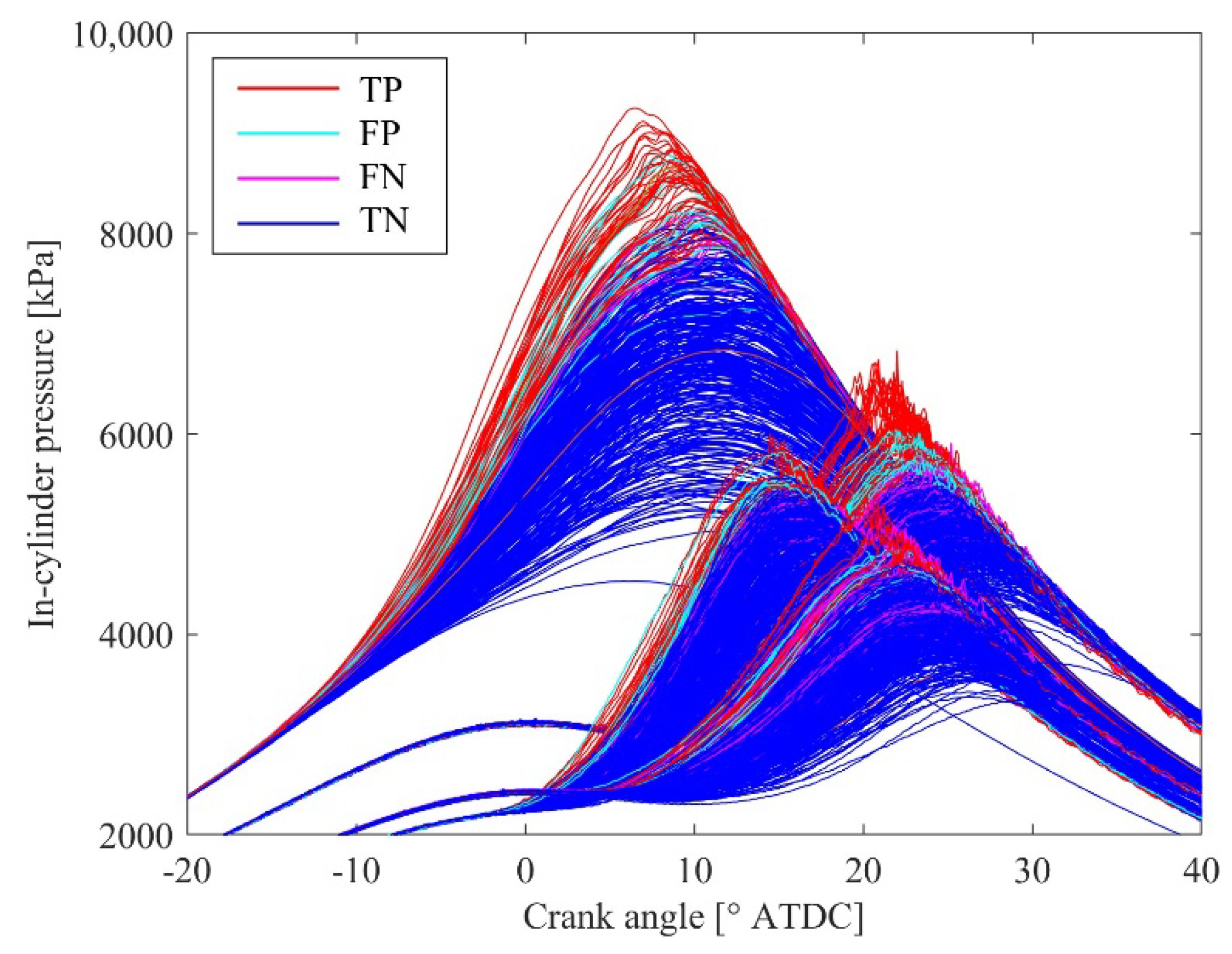
| Displacement volume [cc] | 563.3 |
| Bore [mm] | 75.0 |
| Stroke [mm] | 127.5 |
| Compression ratio [-] | 15 |
| Number of valves [-] | 4 |
| Fuel injection system | Port fuel injection |
| Supercharger | Electric supercharger |
| Intake valve open [° ATDC] | −390 |
| Intake valve close [° ATDC] | −94 |
| Exhaust valve open [° ATDC] | 166 |
| Exhaust valve close [° ATDC] | 390 |
| k | Training Accuracy [%] | Test Accuracy [%] | Precision [%] | Recall [%] |
|---|---|---|---|---|
| 1 | 87.50 | 91.14 | 77.78 | 58.33 |
| 2 | 84.38 | 92.41 | 75.00 | 75.00 |
| 3 | 87.50 | 91.14 | 69.23 | 75.00 |
| 4 | 81.25 | 93.67 | 81.82 | 75.00 |
| 5 | 87.50 | 88.61 | 61.54 | 66.67 |
| average | 85.63 | 91.39 | 73.07 | 70.00 |
| standard deviation | 2.80 | 1.88 | 7.91 | 7.45 |
| Operating Condition | ➀ | ➁ | ➂ | ➃ | |
|---|---|---|---|---|---|
| Fuel | S5H | CP50 | NM5 | ||
| Fuel component [vol. %] | n-Heptane | 10.0 | 5.0 | 9.5 | |
| Isooctane | 31.0 | 15.5 | 29.45 | ||
| Toluene | 40.0 | 20.0 | 38.0 | ||
| Methylcyclohexane | 5.0 | 2.5 | 4.75 | ||
| Diisobutylene | 14.0 | 7.0 | 13.3 | ||
| Cyclopentane | - | 50.0 | - | ||
| Nitromethane | - | - | 5.0 | ||
| Operating specifications | Engine speed [rpm] | 2000 | |||
| Equivalence ratio [-] | 0.476 | 1.0 | |||
| Spark timing [° ATDC] | −31.5 | −6.6 | 0.4 | −1.5 | |
| IMEP [MPa] | 0.8 | 0.8 | 1.0 | 0.8 | |
| k | Training Accuracy [%] | Test Accuracy [%] | Precision [%] | Recall [%] |
|---|---|---|---|---|
| 1 | 87.50 | 89.62 | 71.43 | 52.08 |
| 2 | 84.38 | 89.31 | 66.67 | 58.33 |
| 3 | 84.38 | 87.42 | 57.41 | 64.58 |
| 4 | 71.88 | 86.16 | 55.88 | 39.58 |
| 5 | 87.50 | 88.36 | 72.00 | 37.50 |
| average | 83.13 | 88.18 | 64.68 | 50.42 |
| standard deviation | 6.48 | 1.42 | 7.64 | 11.73 |
Publisher’s Note: MDPI stays neutral with regard to jurisdictional claims in published maps and institutional affiliations. |
© 2022 by the authors. Licensee MDPI, Basel, Switzerland. This article is an open access article distributed under the terms and conditions of the Creative Commons Attribution (CC BY) license (https://creativecommons.org/licenses/by/4.0/).
Share and Cite
Tajima, H.; Tomidokoro, T.; Yokomori, T. Deep Learning for Knock Occurrence Prediction in SI Engines. Energies 2022, 15, 9315. https://doi.org/10.3390/en15249315
Tajima H, Tomidokoro T, Yokomori T. Deep Learning for Knock Occurrence Prediction in SI Engines. Energies. 2022; 15(24):9315. https://doi.org/10.3390/en15249315
Chicago/Turabian StyleTajima, Haruki, Takuya Tomidokoro, and Takeshi Yokomori. 2022. "Deep Learning for Knock Occurrence Prediction in SI Engines" Energies 15, no. 24: 9315. https://doi.org/10.3390/en15249315
APA StyleTajima, H., Tomidokoro, T., & Yokomori, T. (2022). Deep Learning for Knock Occurrence Prediction in SI Engines. Energies, 15(24), 9315. https://doi.org/10.3390/en15249315







